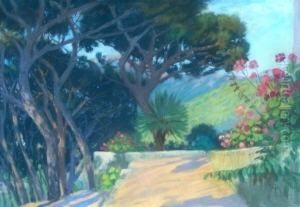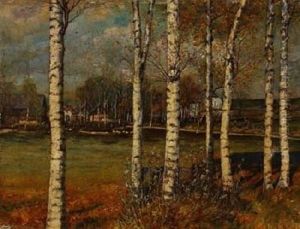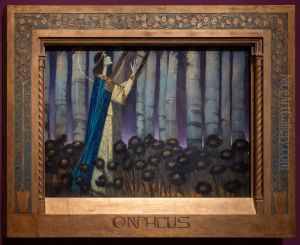Melchior Lechter Paintings
Melchior Lechter was a German painter, illustrator, and stained glass artist, whose work is often associated with the Symbolist movement and the Jugendstil, the German variant of Art Nouveau. Born on April 2, 1865, in Münster, Germany, Lechter's artistic journey began at the Royal Academy of Arts in Berlin, where he honed his skills and developed a distinctive style characterized by meticulous detail, a rich color palette, and often mystical or spiritual themes.
Lechter's career was significantly influenced by his association with the literary and artistic circles of his time, notably the poet Stefan George. The collaboration between Lechter and George was particularly fruitful, with Lechter illustrating several of George's books. These works are celebrated for their harmonious integration of text and image, showcasing Lechter's mastery of graphic design and his sensitivity to the aesthetic interplay between different art forms. His illustrations for George's 'Der siebente Ring' (The Seventh Ring) are particularly acclaimed for their beauty and intricacy.
In addition to his work as an illustrator, Lechter was renowned for his stained glass designs. His contributions to this medium are considered among the finest examples of Jugendstil stained glass art, characterized by flowing lines, vibrant colors, and often, themes drawn from nature, mythology, or spirituality. Lechter's stained glass works adorn several public and private buildings, reflecting his ability to blend artistic expression with architectural context.
Melchior Lechter's legacy extends beyond his contributions to painting, illustration, and stained glass art. He was a key figure in the development of the Jugendstil movement in Germany, influencing not only his contemporaries but also future generations of artists. Despite facing criticism from some quarters for his ornate style and the perceived esoteric nature of his subjects, Lechter remained committed to his artistic vision, which sought to transcend the material world and explore mystical and spiritual dimensions.
Lechter's work experienced a resurgence of interest towards the end of the 20th century, as art historians and collectors began to reevaluate the significance of the Symbolist and Jugendstil movements. Today, his works are held in high regard, featured in museum collections and exhibitions dedicated to the art of this period. Melchior Lechter passed away on October 25, 1937, in Berlin, but his artistic legacy continues to inspire admiration and scholarly interest.


